Aegopodium podagraria
Aegopodium podagraria (commonly called ground elder, herb gerard, bishop's weed, goutweed, gout wort, and snow-in-the-mountain, and sometimes called English masterwort[2] and wild masterwort[2]) is a perennial plant in the carrot family (Apiaceae) that grows in shady places. The name "ground elder" comes from the superficial similarity of its leaves and flowers to those of elder (Sambucus), which is unrelated. It is the type species of the genus Aegopodium. This species is native to Eurasia, and has been introduced around the world as an ornamental plant, where it occasionally poses an ecological threat as an invasive exotic plant.[3]
| Aegopodium podagraria | |
|---|---|
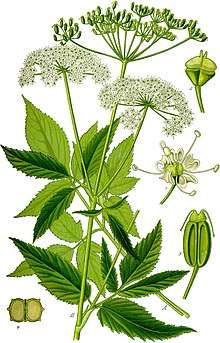 | |
| Illustration from Otto Wilhelm Thomé's Flora von Deutschland, Österreich und der Schweiz (1885) | |
| Scientific classification | |
| Kingdom: | Plantae |
| Clade: | Tracheophytes |
| Clade: | Angiosperms |
| Clade: | Eudicots |
| Clade: | Asterids |
| Order: | Apiales |
| Family: | Apiaceae |
| Genus: | Aegopodium |
| Species: | A. podagraria |
| Binomial name | |
| Aegopodium podagraria | |
| Synonyms[1] | |
| |
Description
A. podagraria is perennial, growing to a height of 100 cm (39 in) with rhizomes. The stems are erect, hollow, and grooved. The upper leaves are ternate, broad and toothed. Numerous flowers are grouped together in an umbrella-shaped flowerhead known as a compound umbel. The main umbel is further divided into several secondary umbels known as umbellets or umbellules. Each umbellet has 15 to 20 rays (pedicels) that are each topped with a single, small, five-petaled white flower.[4][5][6]
The fruits are small and have long curved styles.[7][8] The flowers are visited by many types of insects, thus being characterised by a generalised pollination system.[9]
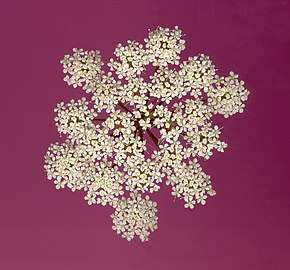 Flowerhead from above, each secondary umbel (umbellet) with 15 to 20 rays
Flowerhead from above, each secondary umbel (umbellet) with 15 to 20 rays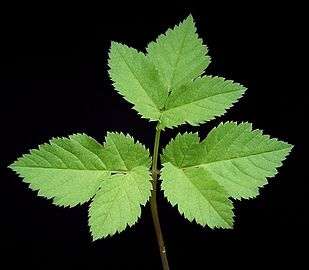 Basal leaf
Basal leaf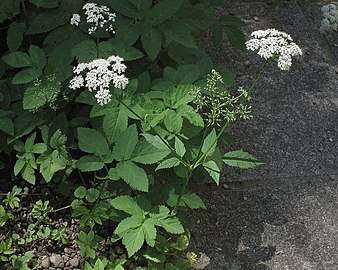 Entire plant
Entire plant%2C_rostlinstvo_(002).jpg) Spreading habit
Spreading habit
Distribution
Aegopodium podagraria is distributed widely in the temperate zone of western Eurasia, from France to northern Russia.[10] It has been introduced elsewhere, including Ireland,[11] Great Britain,[12] the United States,[13] Canada,[13] Australia including Tasmania,[14] New Zealand,[15] and Japan.[16]
Invasive habit
Seed dispersal and seedling establishment is typically limited by shading, and new establishments from seed are restricted to disturbed areas. However, Aegopodium podagraria readily spreads over large areas of ground by underground rhizomes. Once established, the plants are highly competitive, also in shaded environments, and can reduce the diversity of ground cover, and prevent the establishment of tree and shrub seedlings. Because of its limited seed dispersal ability, short-lived seed bank and seedling recruitment, the primary vector for dispersal to new areas are human plantings as an ornamental, medicinal or vegetable plant, as well as by accidentally spreading rhizomes by dumping of garden waste. It spreads rapidly under favorable growing conditions.[17] Because of this it has been described as a nuisance species,[18] and been labeled one of the "worst" garden weeds in perennial flower gardens.[17]
Status as an invasive exotic plant
A. podagraria has been introduced around the world, including in North America, Australia, New Zealand, and Japan, most commonly as an ornamental plant. It readily establishes and can become naturalized in boreal, moist-temperate, and moist-subtropical climates. It is an "aggressive" invader in the upper Great Lakes region and northeastern North America, Australia, Tasmania, and New Zealand.[14] It can pose an ecological threat due to its invasive nature, with potential to crowd out native species.[3] Because of its potential impacts on native communities and the difficulty of its control, it has been banned or restricted in some jurisdictions outside its native range, including in Connecticut, Massachusetts, Wisconsin (see Administrative Code NR 40), and Vermont in the USA.[13]
Control
-1.jpg)
Once established, goutweed is difficult to eradicate. The smallest piece of rhizome left in the ground will quickly form a sturdy new plant. All-green goutweed may be more persistent and spread more rapidly than ornamental, variegated goutweed varieties, making the all-green type particularly difficult to control. And all-green, wild type forms are known to reappear from seeds of variegated varieties.
Integrative management strategies that combine herbicide with landscape cloth, bark mulch, and hand weeding to control goutweed in a garden are largely unsuccessful because sprouting occurs from either rhizomes or root fragments left in the soil.[19] Hand pulling, raking, and digging followed by monitoring to control goutweed may be effective; however, caution must be taken to remove the entire rhizome and root system. Removing flowers before seed set may help control the spread of goutweed.[20] Because goutweed's starch reserves are typically depleted by spring, removal of leaves in spring could be effective in starving the plant. Once goutweed has been removed, the patch should be carefully monitored periodically for a few years. New shoots should be dug up and destroyed. Revegetation with other plant materials is recommended.
The most effective means of control is to prevent its establishment in natural communities. It is thus recommended to plant goutweed only on sites not adjacent to wildlands and in gardens where root spread can be restricted (e.g., between a sidewalk and a house).[18]
Ornamental use

A variegated form is grown as an ornamental plant, though with the advice to keep it isolated.
Ecology
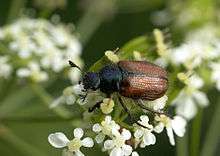
In Eurasia, it is used as a food plant by the larvae of some species of Lepidoptera, including dot moth, grey dagger and grey pug, although A. podagraria is not the exclusive host to any of these species.
Uses as food and medicine
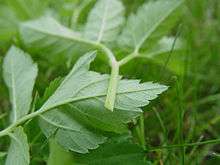
The tender leaves have been used in antiquity and throughout the Middle Ages as a spring leaf vegetable, much as spinach was used. It is commonly used for soup. Young leaves are preferred as a pot herb. It is best picked from when it appears (as early as February in the UK) to just before it flowers (May to June). If it is picked after this point, it takes on a pungent taste and has a laxative effect. However, it can be stopped from flowering by pinching out the flowers, ensuring the plant remains edible if used more sparingly as a pot herb.[21]
It also had a history as a medicinal herb to treat gout and arthritis,[22] applied in hot wraps externally upon boiling both leaves and roots together. Ingested, the leaves have a diuretic effect and act as a mild sedative. Its use as a medicinal herb has largely declined during the modern era.
The plant is said to have been introduced into Great Britain by the Romans as a food plant and into Northern Europe as a medicinal herb by monks. It is still found growing in patches surrounding many monastic ruins in Europe, and descriptions of its use are found among monastic writings, such as in Physica by Hildegard von Bingen.
References
| Wikimedia Commons has media related to Aegopodium podagraria. |
- "Aegopodium podagraria L.". World Checklist of Selected Plant Families (WCSP). Royal Botanic Gardens, Kew. Retrieved 5 December 2014 – via The Plant List.
- Grieve, Maud (1931). "Goutweed (Aegopodium podagraria)". A Modern Herbal – via Botanical.com.
- "Goutweed (Aegopodium podgraria)". Plant Conservation Alliance, Alien Plant Working Group. Archived from the original on 2017-04-02.
- "Aegopodium podagraria". Go Botany. New England Wildflower Society. Retrieved 15 January 2019.
- Hilty, John. "Goutweed, Aegopodium podagraria". Illinois Wildflowers. Retrieved 15 January 2019.
- "Monographs Details: Aegopodium podagraria L." World Flora Online. Retrieved 15 January 2019.
- Webb, D.A.; Parnell, J.; Doogue, D. (1996). An Irish Flora. Dundalk: Dundalgan Press. ISBN 0-85221-131-7.
- Parnell, J.; Curtis, T. (2012). Webb's An Irish Flora. Cork University Press. ISBN 978-185918-4783.
- Van Der Kooi, C. J.; Pen, I.; Staal, M.; Stavenga, D. G.; Elzenga, J. T. M. (2015). "Competition for pollinators and intra-communal spectral dissimilarity of flowers" (PDF). Plant Biology. 18: 56–62. doi:10.1111/plb.12328. PMID 25754608.
- "Aegopodium podagraria L". Plants of the World Online. Royal Botanic Gardens, Kew. Retrieved 2019-01-15.
- Scannell, M. P.; Synott, D. M. (1972). Census Catalogue of the Flora of Ireland. Dublin: Stationery Office.
- Clapham, A. R.; Tutin, T. G.; Warburg, E. F. (1968). Excursion Flora of the British Isles. Cambridge University Press. ISBN 0-521-04656-4.
- "Aegopodium podagraria". Natural Resources Conservation Service PLANTS Database. USDA. Retrieved 15 January 2019.
- Waggy, Melissa A. (2010). "Aegopodium podagraria". Fire Effects Information System (FEIS). US Department of Agriculture (USDA), Forest Service (USFS), Rocky Mountain Research Station, Fire Sciences Laboratory – via https://www.feis-crs.org/feis/.
- "Aegopodium podagraria". New Zealand Plant Conservation Network. Retrieved 15 January 2019.
- Mito, T., and T. Uesugi. 2004. Invasive Alien Species in Japan: The Status Quo and the New Regulation for Prevention of their Adverse Affects. Global Environmental Research. 8(2). 171-191 p.
- Agronomy Division (1969). "Ground elder (Aegopodium podagraria)". Tasmanian Journal of Agriculture. 40 (30): 190.
- Dawson, F. Hugh; Holland, David. (1999). "The distribution in bankside habitats of three alien invasive plants in the U.K. in relation to the development of control strategies". Hydrobiologia. 15: 193–201. doi:10.1007/978-94-017-0922-4_27.
- Clark, Frances H.; Mittrick, Chris; Shonbrun, Sarah. (1998). "Rogues gallery: New England's notable invasives". Conservation Notes of the New England Wild Flower Society. 2 (3): 19–26.
- Czarapata, Elizabeth J. (2005). Invasive plants of the Upper Midwest: An illustrated guide to their identification and control.
- "Ground Elder - Bishops Weed (Aegopodium podagraria)". Edible Plants. 27 January 2011. Archived from the original on 10 July 2011.CS1 maint: BOT: original-url status unknown (link)
- Hill, John (1812). The Family Herbal. Bungay: C. Brightly and T. Kinnersley. p. 157.